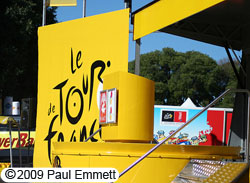 Twelve years after a mass pile-up effectively destroyed Alex Zuelle’s chances in the 1999 Tour de France, the race will return to the Passage du Gois for the first stage of the 2011 edition.
Twelve years after a mass pile-up effectively destroyed Alex Zuelle’s chances in the 1999 Tour de France, the race will return to the Passage du Gois for the first stage of the 2011 edition.
Provided it is not neutralised, the inclusion of the 4.5 kilometre paved road between the island of Noirmoutier and Beauvoir-sur-Mer, in the department of Vendée, will introduce an element of risk to the Grand Départ.
The route is flooded twice a day at high tide, making it a slippery, testing surface for the riders.
Stage one will begin on Saturday July 2nd with a 180 kilometre stage running from the island to the Mont des Alouettes. The finish is a short uphill climb, reaching an attitude of 232 metres above sea level, and will further increase the spectacle.
Day two sees the team time trial return to the race, with the riders clashing in a 23 kilometre test at Les Essarts. The race will continue the following day with a stage beginning in Olonne sur Mer. Further details have not yet been released, and so the stage distance and finishing location remain unknown.
Holding three stages in the Vendée is, according to race director Christian Prudhomme, a reflection of the support cycling has in the region.
“If I had to use just one word to define the links that unite the Vendée and the Tour, without hesitation I would say: passion!” said Prudhomme.
“A shared passion for an event that is a century old, a wonderful popular celebration and for an authentic and innovative land, a place of liberty and challenges, where traditions and the future live in harmony.”
The race previously started in the area in 1976, 1993, 1999 and 2005. Miguel Indurain dominated the prologue in 1993, while Armstrong did likewise six years later.
 Dave Zabriskie beat the Texan in the 2005 race against the clock, which went to Noirmoutier but used a road bridge rather than the Passage du Gois.
Dave Zabriskie beat the Texan in the 2005 race against the clock, which went to Noirmoutier but used a road bridge rather than the Passage du Gois.
Prudhomme remembers the previous edition with fondness. “Of all the many images of the Tour that I can remember, the pack crossing the Passage du Gois in 1999 is definitely one of the most exciting,” he said. “In fact, [it is] probably the finest that I have ever seen on a flat stage.”
Zuelle (Banesto) was amongst a large number of riders who crashed on the slippery surface during the third day of the race. Armstrong’s US Postal team and the ONCE squad ramped up the pace to prevent them returning, and the Swiss rider ended up losing six minutes and three seconds.
He finished seven minutes 37 seconds behind Armstrong in Paris.
Prudhomme’s statement made it a little unclear if the riders will go flat out on the Passage du Gois. “Since the tide allows us, we will be back on this inimitable road in July 2011, during the initial parade, before the official starting ceremony, several minutes before the actual start of the race.”
He described the finish on the Mont des Alouettes as one where ‘punchers [explosive riders] and sprinters will battle for the first Maillot Jaune of the 98th Tour de France.”
The following day’s team time trial is just 23 kilometres long, 16 less than that which featured in last year’s Tour. Time gaps should be relatively tight, but it will nevertheless open gaps in the general classification.
Full details of the 2011 Tour will be released at the official presentation later this year.